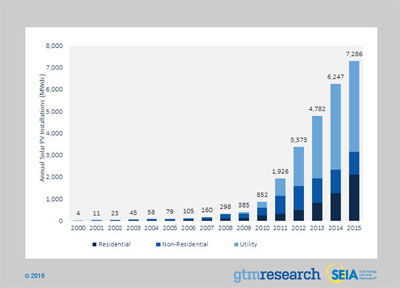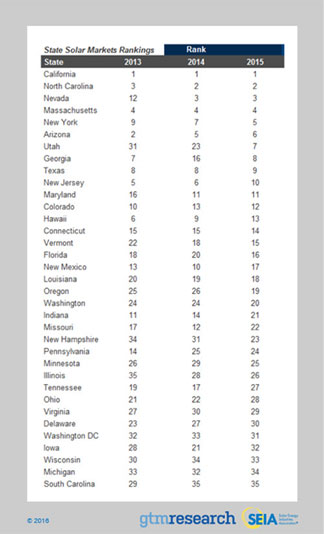Solar installations in the US have been breaking records for years and this wonderful trend continued in 2015.
The US now has a total 25 gigawatts of solar installed, an amazing increase from just 2 GW in 2010, according to GTM Research and Solar Energy Industries Association (SEIA) in a preview of their annual report.
Perhaps the best news is that solar has reached grid parity in 20 states, and by 2020 – just four years! – that will spread to 42 states, says GTM Research.
Last year, a record 7.3 gigawatts (GW) connected to the grid, a rise of 17%, and for the first time, more solar was added than natural gas – almost 30% of all new electric capacity in the US.
As of November 2015, 209,000 people are employed by the US solar industry.

Residential solar grew the most – by an impressive 66% – surpassing a cumulative 2 GW for the first time. Home-based solar now accounts for 29% of all US installations.
For the fourth year, non-residential distributed solar broke the 1 GW mark, but remained roughly flat year-over-year. Large-scale solar added another 4 GW, from projects like Crescent Dunes in Nevada, the first commercial-scale molten salt tower in the world.
Corporate Adoption of Solar Zooms
While it may not show yet in the totals, corporations are adopting solar in droves, most for the first time, according to the Business Renewables Center. They are signing long term contracts to buy solar electricity from the big projects, for example.
Read our article, 53 Major Companies Achieve 50% Renewable Energy.
Top States for Solar
The top 5 states for 2015 are California, North Carolina, Nevada, Massachusetts and New York, and Utah jumped from #23 to #7, and Georgia from #16 to #8.
While the top 10 states account for 87% of all solar installations, the market is growing in 24 states.
California, Massachusetts and Hawaii have the strongest incentives and North Dakota, Oklahoma and Washington have the weakest.

"To date, the residential solar market’s growth has primarily come from a handful of states where favorable rate structures and net metering rules have set high, predictable ceilings on savings due to solar," says Cory Honeyman at GTM Research.
Sadly, the headwind for solar is push-back from utilities (and ALEC), trying to add fees and eliminate net metering in 30 states, like we recently saw in Nevada. Adding a $50 monthly charge for residential solar, for example, reduces the states at grid parity to just two, calculates GTM.
Often the problem is that states set caps for net metering and when they meet them, they too often let them expire.
ITC Extension Makes All the Difference
With the extension of the Solar Investment Tax Credit (ITC) for five years, the 30% tax deduction will, at least partially, counter utility backlash.
It’s expected to increase solar capacity in the US 54% over that time, bringing the total to 59 GW by 2021, and double the number of jobs. And that’s even with low natural gas prices.
"Our research shows a transition to a reliable, low-carbon, electrical generation and transmission system can be accomplished with commercially available technology and within 15 years," says Alexander MacDonald, co-lead author of a major NOAA study.
Read our article, 2015: Another Banner Year for Renewable Energy Worldwide.
